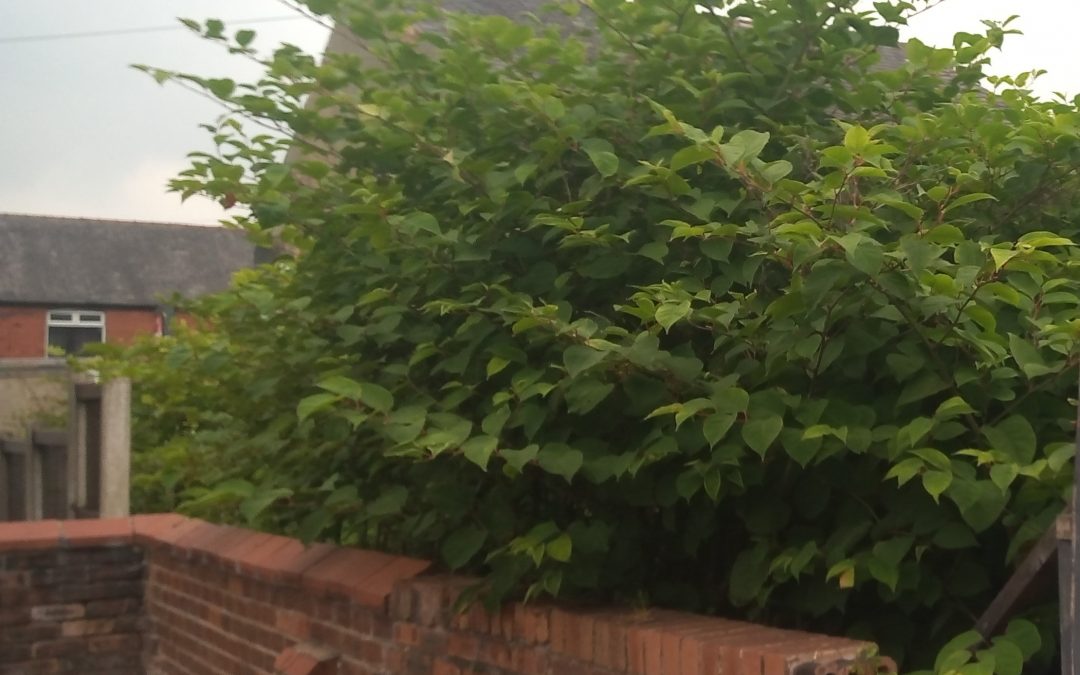What kills Giant Knotweed?
We will investigate what kills Giant Knotweed ? and examine the differences between Giant and Japanese knotweed. They are both invasive plant species. They belong to the same family, Polygonaceae. Furthermore, they share some similarities. However, there are a few key differences between them:
- Taxonomy: Giant knotweed is scientifically known as Fallopia sachalinensis, and Japanese knotweed is known as Fallopia japonica. They are two different species within the same genus.
- Size: Giant knotweed generally grows larger than Japanese knotweed. Giant knotweed can reach heights of up to 15 feet (4.5 meters) or more. Japanese knotweed usually grows to about 6-10 feet (1.8-3 meters) tall.
- Leaf Shape: The leaves of giant knotweed are generally broader and more heart-shaped. Compared to the narrower, somewhat elongated leaves of Japanese knotweed.
- Stem Colour: The stem of giant knotweed is typically reddish-brown or dark brown, while the stem of Japanese knotweed is usually green with purple speckles.
- Habitat: Giant knotweed is native to Sakhalin Island in Russia and the Far East and is commonly found in northern regions, including parts of Asia, Europe, and North America. As the name suggests, Japanese knotweed is native to Japan but has spread to other parts of the world, including Europe, North America, and New Zealand.
Both giant knotweed and Japanese knotweed are considered highly invasive species.
- Invasiveness: Both giant and Japanese knotweed are considered highly invasive species. However, Japanese knotweed is generally considered more problematic and widespread in its invasiveness. Its ability to spread rapidly and persistently through rhizomes (underground stems) makes it particularly difficult to control.
- Chemical Control: Using herbicides can effectively kill Japanese knotweed. However, it may take multiple applications over several years to eradicate the plant. Using the herbicide according to the label directions and considering the surrounding ecosystem is essential, as it could impact other plants.
- Physical Control: Cutting or mowing the plant can help to slow its growth, but it will not kill the roots. Repeated cutting can weaken the plant but is not a long-term solution.
- Biological Control: Insects or pathogens specific to Japanese knotweed can be used to control its growth. However, this method is still in the research phase and not yet widely available.
- Excavation: This method is the most effective, expensive, and disruptive. The entire plant, including the roots, must be removed and disposed of properly to prevent regrowth.
It is important to note that killing giant knotweed is a long process, and it’s important to stay vigilant as it can regrow from tiny fragments of roots or rhizomes.
Best not to cut Giant Knotweed
furthermore, if Giant Knotweed (Fallopia sachalinensis) is cut aboveground, the rhizomes (underground stems) of the plant can utilise nutrient stores to send up new shoots. Giant Knotweed is known for its aggressive growth and reproductive capabilities through its extensive rhizome system. Cutting the aboveground growth may temporarily suppress the plant, but the rhizomes can remain active and initiate the growth of new shoots when conditions are favourable.
The nutrients stored in the rhizomes of Giant Knotweed are primarily carbohydrates and starches. These substances serve as energy reserves that the plant can utilise to support new growth when the aboveground portion of the plant is cut or damaged. The rhizomes store these nutrients to sustain the plant during periods of dormancy or limited resources. By tapping into these nutrient stores, the plant can allocate resources for producing new shoots and leaves, allowing it to regenerate and continue its growth cycle.
Induce dormancy
it is possible to induce dormancy in plants, including Giant Knotweed, by applying excessive amounts of herbicide. Herbicides are chemical substances specifically designed to kill or inhibit the growth of plants. When applied in high concentrations, herbicides can harm plants’ overall health and growth, potentially leading to dormancy.
Excessive herbicide application can disrupt a plant’s normal physiological processes, damaging its tissues and interfering with its ability to photosynthesize and obtain essential nutrients. In response to the stress caused by the herbicide, plants may enter a state of dormancy as a survival mechanism.
However, it’s important to note that inducing dormancy through excessive herbicide application may not always be desirable or practical for long-term control of Giant Knotweed. While it may temporarily suppress the plant’s growth, the rhizomes can remain viable underground and initiate new growth when conditions become more favourable.
